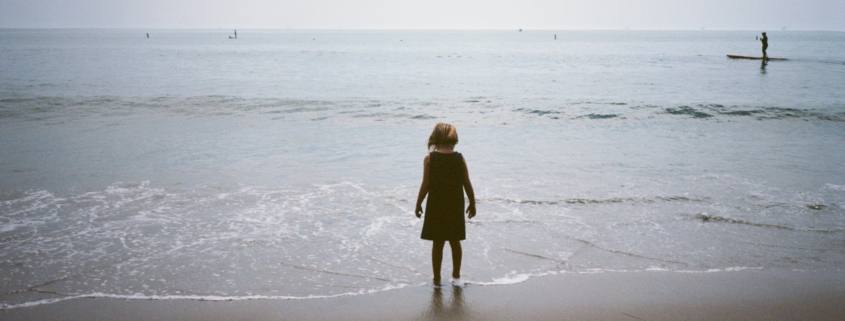Facing the Wave
The plan was to go back to Montecito—where, a few days after the Thomas Fire had reached containment, waist-deep mudslides triggered by heavy rain decimated the community. The fire had burned through approximately 281,893 acres, across the Ventura and Santa Barbara counties, destroyed 1,063 structures, and forced over 104,607 residents to evacuate their homes and then this. Twenty-one residents were killed, while three remained missing, a number I assumed would change. And while first responders sifted, cadaver dogs sniffed, and front loaders deposited sludge, I found myself, once again, behind the glow of my computer screen.
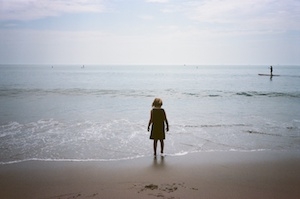 Since the event, I had read all the reports in Los Angeles Times, followed up with friends who lived in the area, texted a ten-dollar donation to the Red Cross and scrolled through the list of victims, ages three to eighty-nine, familiarizing myself with their faces and names, but all of that felt distant and detached, sort of meaningless.
Since the event, I had read all the reports in Los Angeles Times, followed up with friends who lived in the area, texted a ten-dollar donation to the Red Cross and scrolled through the list of victims, ages three to eighty-nine, familiarizing myself with their faces and names, but all of that felt distant and detached, sort of meaningless.
I had to see it for myself.
It was not lost on me that I was drawn towards devastation—that I was seeking my way into an evacuation site, with the inclination not just to face the aftermath of a catastrophe, but to experience it. I decided that I no longer wanted to consider the state of the world through the looking glass of a handheld screen.
So on the morning of Monday, January 22nd, when the 101 Freeway to Santa Barbara reopened, after nearly two weeks of closure, I jumped.
* * *
As I merge onto the 405 North, in my hometown of Los Angeles, I am flanked by the scorched-black hills of the Skirball Fire, which blazed across 422 acres earlier in December, burning down six homes and damaging twelve. It shut down the freeway and many of the schools in the area, while it skirted dangerously close the Getty Museum. I remember those unusual days, just weeks ago, when residents wore surgical masks and sheets of papery ash blanketed the streets, as I drive the eighty or so miles to Santa Barbara, skating past swells of pavement and the Pacific Ocean. It isn’t until I reach the city of Carpinteria, a few stops before Montecito, when an image grabs me: a charred palm tree split down the middle. Its singed, waxy fronds hang in a hunched way, sadistically, like a balloon that’s lost its air.
“Thank You, Firefighters,” a large, crinkled banner flutters by, followed by an explosion of orange cones that usher traffic forward, while ruby red signs blink “Disaster Trucks” towards their appropriate exits. A solitary white bird, most likely a seagull, soars overhead, as I veer down the off-ramp, passing a succession of blackened tree trunks.
Yellow caution tape spreads across the scene, reflecting red and blue sirens against its taut, plastic face. Yellow, seems to me, like the least likely color to conjure caution, to dismiss the slightest shred of curiosity. It is certainly not enough to dispel my own—so I keep going.
After passing a barrage of Southern California Electric vans, straddling two football field-sized parking lots, I enter the outskirts of Montecito. I turn down a residential street, where the air is still and littered with dust, as if the particles themselves have divided, but remain hanging. A ring of caution tape drapes around a Range Rover’s side mirror, while the burnt carcass of a less fortunate car lays at the bottom of a muddy ditch.
A couple homes are slumped, two-toned as if dipped in faded ink. Front doors are closed; some are missing from their hinges. I scan the terrain as if I was back home, scrolling down the list of names. I think about Josephine Gower, 69, who was known as the life of the party, Peter Fluerat, 73, who apparently liked to do silly, off-the wall things just to see how people would react, and Peerawat Sutthithepa, 6, who adored trains and was known as Pasta. They’re all smiling in their pictures.
There are no signs of life here besides one woman who stands in the middle of the road, holding a matted brown dog.
She wears yellow dish gloves and galoshes.
* * *
Six months earlier, I entered Eucalyptus Lane for the first time with my boyfriend, Brian, to spend the weekend with his family. The lip of his surfboard was strapped to the car’s roof. It protruded over the windshield, both enhancing and obstructing my view. Clumps of bougainvillea that I had collected were scattered across the dash. We were headed to the beach so that he could catch some waves and I could take photographs with my favorite point and shoot camera.
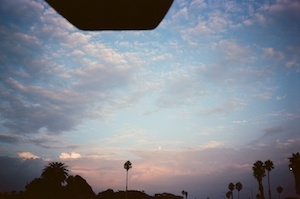 As my long hair whipped against the open window, we cruised down the main stretch of restaurants and shops, on Coast Village Road, past the wooded streets, lined with bubbling creeks and bridges, past the wide iron gates protecting sprawling Spanish estates. The streets buzzed with life: joggers’ soles beat forward, children caught ice cream drippings from their chins, neighbors waved and jingled keys, a couple clinked glasses as a bowl of pasta steamed between them. The air was electric with traces of ocean spray and overhanging eucalyptus.
As my long hair whipped against the open window, we cruised down the main stretch of restaurants and shops, on Coast Village Road, past the wooded streets, lined with bubbling creeks and bridges, past the wide iron gates protecting sprawling Spanish estates. The streets buzzed with life: joggers’ soles beat forward, children caught ice cream drippings from their chins, neighbors waved and jingled keys, a couple clinked glasses as a bowl of pasta steamed between them. The air was electric with traces of ocean spray and overhanging eucalyptus.
It was the most enchanting place.
* * *
Coast Village Road is now dusted in rusty dried mud. Drooping signs thanking the firefighters flag the median, while Christmas decorations hang overhead, an entire month past due. A tall man in glasses dusts the front windows of his realty office with a sponge, while another bends on all fours, scraping caked mud off the sidewalk. One storefront is pulverized. Collapsed and skeletal, it looks like it belongs underwater. Although there is movement— truck beds clink by, news vans shut their doors, a woman walks a pair of chirping terriers— it feels languid.
I pull into one of the many open parking spots and walk through the open door of Honor Market, where six months ago, the coffee shop was bustling, but now the only other person inside of it is a young waitress with a high, blonde ponytail who asks me what I’d like. I order a cappuccino, admiring the sleek liquid cat-eye she has applied to her lids. I marvel at the effort she has put into presenting herself on a day like today.
“Did you just open this afternoon?” I ask, as she bangs used coffee grounds out of a brass canister.
“Yeah. Got here about eight, opened around noon.” She pours milk from a cardboard container, squeezes its torso into a small, metal pitcher.
“How are you doing?” I ask. She takes a breath and when she sucks the air in, her lip begins to quiver. She braces the metal pitcher against the hot, spitting steam wand.
“Well,” she says against the steam wand’s screams, “it’s uh, well, you know.”
What do I know? What do I know about water-laden masses of soil and fragmented rock careening down mountainsides, sucking up objects like boulders and cars, bulldozing homes and businesses that took years to build, guzzling up owners, friends, parents, pets, lovers, children, sucked clean out through doors, through windows, through roofs ripped open at their hinges, out in the cold, out in the middle of the night?
What do I know about all that?
* * *
 Brian and I did not know that Miramar Beach existed, until we arrived there that day, quite accidentally; when a cul-de-sac and an empty parking spot appeared, the big blue flickering beyond. I got out with my camera and took a picture.
Brian and I did not know that Miramar Beach existed, until we arrived there that day, quite accidentally; when a cul-de-sac and an empty parking spot appeared, the big blue flickering beyond. I got out with my camera and took a picture.
Down on the beach, he paddled out, while I sat down on a stretch of sand that was white and narrow. An arc of houses branched out behind me, as I watched a few dogs scuttle against the shore. A father dipped his floaties-wearing toddler into the wake, while his other daughter waded out to sea. She paused in reflection, locked in thought, while a breeze twirled her dress’s hem. I took another photo.
As I looked up from the viewfinder and watched this family in motion, I thought about my own father and his steady decline into Alzheimer’s. Day by day, piece by piece, and word by word: stripped away. His disease took everything else with it. It deteriorated the family. Friends vanished. It took my will and fortitude. I missed him all the time, even when I was with him. I missed him even more when I wasn’t.
When Brian came back in to catch his breath, he put his board down to rest. The salty globs of wax glistened in the sun, as if calling me towards it. And so I went—I put down my camera and hoisted the heavy white board underneath one arm. I plunged into the water, which was colder than I remembered cold ever being, especially considering that all I had on was a minuscule bikini. I paddled out, dug my arms into the ocean. It was the first time in fifteen years since I had been on a board. It was even longer since I’d attempted to brave the waves without my dad. The ocean was our thing.
The waves barreled towards me, bumped underneath my belly. Each swell grew higher, fuller, and more monstrous. Brian, tough and sweet, swam out to meet me.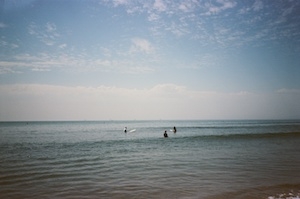
“I’m nervous,” I said, watching the waves crest.
“Don’t be,” he said, taking the board and turning it. “I’m going to push you.”
“Don’t push me,” I said, though also paddling forward.
“Okay,” he said, pushing me.
The current dragged me, water rushing faster and faster, climbing higher and higher towards the peak of the wave. The wave took me and so I let it.
* * *
Outside the coffee shop, on Coast Village Road with my steaming cappuccino in hand, I notice a bougainvillea bush burned completely, except for a single strand—one magenta cluster strains towards the sky with an unwillingness to perish. Beside it, in front of Jeannie’s restaurant, two residents embrace.
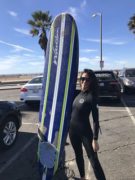 Lily Semel is currently working towards her MFA in Creative Writing at Antioch University in Los Angeles and graduated from UCLA’s Professional Program in Screenwriting in 2017. She serves as Co-Lead CNF Editor at Lunch Ticket and works for two non-profit organizations, Hilarity For Charity, which provides free home care for patients and families suffering from Alzheimer’s disease and MPTF NextGen Board of Directors, which supports the entertainment community in aging and living well. She loves to take photographs and surf.
Lily Semel is currently working towards her MFA in Creative Writing at Antioch University in Los Angeles and graduated from UCLA’s Professional Program in Screenwriting in 2017. She serves as Co-Lead CNF Editor at Lunch Ticket and works for two non-profit organizations, Hilarity For Charity, which provides free home care for patients and families suffering from Alzheimer’s disease and MPTF NextGen Board of Directors, which supports the entertainment community in aging and living well. She loves to take photographs and surf.

